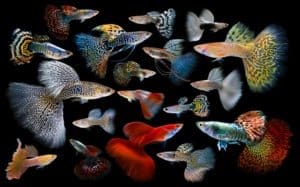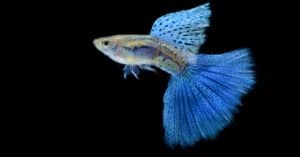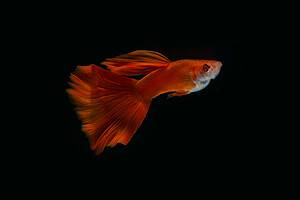Guppies – also known as rainbow fish or millionfish – are small freshwater fish native to South America, where they inhabit slow-moving rivers and streams. However, they are also one of the most popular aquarium fishes worldwide due to their adaptability and stunning colors. They’re also a popular choice for anyone wanting to try to breed their own fish due to their prolific nature. However, it’s always important to know which are the males and which are the females. Although many other species of fish are almost impossible to know the sex, guppies are unique in that there are actually a lot of differences between the males and the females. So join us as we discover everything you need to know about male vs female guppies!
Comparing Female vs Male Guppies

| Female | Male | |
|---|---|---|
| Size | 1.2 to 2.4 inches | 0.6 to 1.4 inches |
| Shape | Bigger and rounder than males | Slender |
| Color | Pale grey or silver | Spots, stripes & blotches in almost any color |
| Tail | Shorter than the males with little to no color | Long and colorful |
| Dorsal Fin | Short and don’t flow | Long and flowing |
| Anal Fin | Triangular | Long and pointed with several hooks on it |
| Gravid Spot | Yes | No |
The 6 Key Differences Between Male and Female Guppies
The differences between male and female guppies are their size, shape, color, tail length, dorsal fin shape, anal fin shape, and presence of gravid spot.
Let’s examine them in detail below.
Male vs Female Guppy: Size & Shape

Male guppies have a slender body compared to females and are much shorter.
©Sarun Khaodara/Shutterstock.com
The first difference between male and female guppies is their size and shape. Guppies exhibit sexual dimorphism, with the females being longer than the males. Male guppies are 0.6 to 1.4 inches long, while females are between 1.2 and 2.4 inches long. Male guppies also have a slim and streamlined body shape, while females are much bigger and rounder. This is particularly enhanced when the female is pregnant as she can be carrying up to 30 guppy fry.
Male vs Female Guppy: Color
Quite easily, the most distinctive difference between males and females is their color. Female guppies are almost always grey or silver. However, males are best known for their bright and vibrant colors. Male guppies have a variety of spots, stripes, and blotches on them which can be virtually any color – making them one of the most stunning small aquarium fish in the world. Despite this, male and female guppies are not immediately distinguishable by color at birth, as it takes around a week for the males to begin to show their colors and around 4 to 6 weeks for them to fully develop their stunning appearance.
Male vs Female Guppy: Tail
Just like the rest of their bodies, the tails of male and female guppies are very different. Female guppies have little to no color on their tails, while males are again bright and vibrant. However, males have a much wider and longer tail than female guppies. The males tend to have a tail that flows behind them, whereas females’ tails are much shorter and don’t flow behind them.
Male vs Female Guppy: Dorsal Fin
Just like their tails, the size of the dorsal fin is different for male and female guppies. In males, it is long and tends to flow with them as they are swimming. However, females have a smaller and shorter dorsal fin which does not flow at all.
Male vs Female Guppy: Anal Fin
Male and female guppies also have different anal fins. Female guppies have a short, triangular anal fin, whereas males have a modified anal fin used as a copulatory organ. The modified anal fin is known as a gonopodium and is used to inseminate the females. It is long and pointy with several hooks on it.
Male vs Female Guppy: Gravid Spot

As well as having bright and vibrant colors, male guppies also lack the gravid spot, which is unique to females.
©panpilai paipa/Shutterstock.com
Another easily noticeable difference between males and females is the presence of a gravid spot only found in females. The gravid spot is a dark spot located over the womb and near the anal fin. When the female is pregnant, the gravid spot tends to get larger and darker the closer she gets to giving birth. After giving birth, it becomes smaller and lighter but doesn’t go away entirely. It then gets larger and darker again the next time she is pregnant.
The photo featured at the top of this post is © Arunee Rodloy/Shutterstock.com
FAQs (Frequently Asked Questions)
How often do male and female guppies reproduce?
The gestation period of guppies is anything from 23 to 35 days depending on a few factors such as water temperature. However, on average, female guppies can give birth every 30 days.
Can female guppies give birth even without a male?
Yes, incredibly female guppies are able to give birth even if they have not been near a male for several months. This interesting phenomenon occurs because they are able to store sperm for up to eight months, allowing them to still keep reproducing every 30 days.
Why are male guppies colorful but not the females?
One of the most popular questions ever asked about guppies is why there is such a difference between the appearance of males and females – or specifically why the females aren’t colorful. After much research, scientists now believe that it comes down to genetics. Scientists from the universities of Edinburgh and Exeter have discovered that guppies have chromosomes which are only able to exchange genes at the very tip – and females lack these chromosomes. This means that they are not able to inherit the color genes. It is also the reason why often (although not all the time) male guppies have similar colors and patterns as their father.
Thank you for reading! Have some feedback for us? Contact the AZ Animals editorial team.







